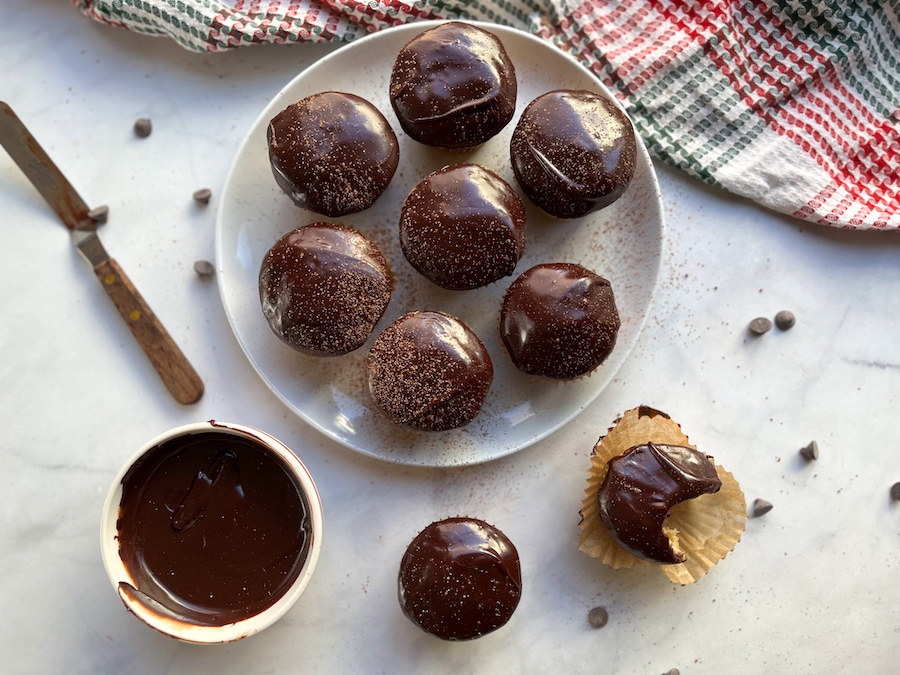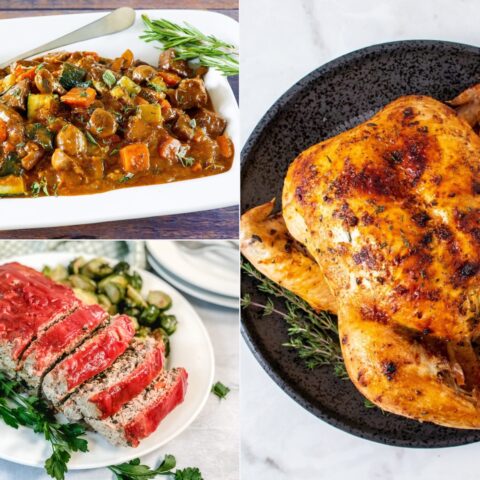How to Bake on The Paleo Diet®

Yes, you can still bake on The Paleo Diet®! In fact, we stand behind baking—for the connection to food it brings to a home and the creativity you get to explore with new recipes. With a few basic swaps, you can easily create healthier-for-you breads, crumbles, cookies, and other treats.
At The Paleo Diet®, we recommend getting most of your nutritional needs met through healthy whole foods like vegetables, fruit, meat, and nuts. We typically recommend against recreating unhealthy foods, like cupcakes, even those that use Paleo ingredients. You would still be eating large amounts of sweeteners and nuts to make the cupcakes taste good, and that’s not what our lifestyle is about.
However, we understand that sometimes you need to have a little treat—and, of course, it’s better to make it without grains, dairy, and sugar whenever possible!
Here’s how to make those occasional treats using better substitutions.
Ingredients to Avoid (& Healthier Replacements)
Before putting on your apron and chef’s hat, let’s go over the common baking ingredients you’ll want to avoid, and how to replace them, while on The Paleo Diet®. If you’ve been eating paleo for a while, this list will likely come as no surprise but will serve as a friendly reminder.
Flour
What to avoid: Grain flours of all kinds are off the list. That includes white or wheat flour, amaranth, barley, and any kind of corn (like cornstarch). Whole grains might appear to be healthy and nutritionally sound, but many of these nutrients have little bioavailability, making them impossible for our bodies to use. Plus, they even contain antinutrients that can harm our health. [1, 2]
What to use instead: There are lots of Paleo-approved flours that you can use in place of grain flours, such as arrowroot, coconut, and almond flour. Just be mindful that many of them cannot be swapped in as an easy 1:1 replacement for all-purpose flour. Here’s a quick guide when making your substitutions:
- Arrowroot Flour: 1 tsp arrowroot flour = 1 TBSP wheat/all-purpose flour
- Coconut Flour: 1/4–1/3 cup coconut flour = 1 cup wheat/all-purpose flour
- Almond Flour: Almond flour can be used 1:1; however, it needs a stronger binding agent, so your recipe may need more eggs.
You may find packaged Paleo baking flours at the store, which often contain a mix of different grain-free flours to create an all-purpose flour that can often be subbed in on a 1:1 scale. Just be sure to check the labels carefully. Some of these products contain tapioca flour, which is not Paleo. Arrowroot starch, however, is fine.
Sugar
What to avoid: Refined sugar is not a part of The Paleo Diet®. It has a high rating on the glycemic index (GI), a negative impact on insulin resistance, and a linkage to obesity in overweight humans, among many other reasons to sidestep it in your diet. [3, 4, 5]
What to use instead: While we recommend keeping any sweetener on the low side, there are a few natural sugars that are Paleo-approved in small amounts. Natural sugar refers to any sugar derived by nature that comes with their natural fibers and enzymes intact, such as maple syrup, raw honey, dates, monk fruit, stevia, and yacon syrup. There’s also a common misconception about coconut sugar—while coconut syrup is okay, coconut sugar is not Paleo!
Dairy
What to avoid: Even if you aren’t lactose intolerant, dairy products can cause all kinds of problems. Similar to sugar, dairy causes insulin spikes, despite it being low on the glycemic index, making the consumption of it similar to eating white bread. [6] Dairy is also a culprit in causing allergies, inflammation, and autoimmune diseases. [7]
What to use instead: Luckily, dairy milk can easily be replaced 1:1 with coconut milk, almond milk, cashew milk, or any other nut milk of your choice. Just be sure to avoid oat milk and soy milk when searching for a good dairy-free alternative.
Fats
What to avoid: Some tend to give butter a free pass while eating Paleo, but the truth is that butter should be avoided. Even ghee and grass-fed butter contain hidden sugars and can contribute to digestive issues.
What to use instead: You can swap in another healthy fat in place of butter, and many of them might even be tastier! Try coconut oil, nut butters, or avocado. You can also use applesauce or pumpkin puree as alternatives to help add moisture to your baked goods, depending on what you’re making. Just be mindful of the ingredients you’re using and how these substitutes will impact the flavor of your baking. Nut butters can have a strong taste, whereas applesauce is much milder and may blend in more seamlessly. Here’s a quick breakdown of how to swap in other ingredients in place of butter:
- Coconut Oil/Nut Butters/Avocado: 1:1
- Unsweetened Applesauce: 1/2 cup applesauce = 1 cup butter
- Pumpkin Puree: 3/4 cup pumpkin puree = 1 cup butter
Chocolate
What to avoid: Most chocolate falls under the sugar and dairy category. Read labels carefully—if your chocolate contains either ingredient, it’s not Paleo! Most processed cocoa and milk chocolate are automatically in this category and should be avoided.
What to use instead: Look for real cacao nibs or cacao powder to use in place of milk chocolate. Cacao is packed full of anti-inflammatory antioxidants like flavonoids, helping to slow down age-related illnesses and reduce the risk of diabetes. [8, 9] You can also find dark chocolate with 85% or higher cacao content and no sugar added if you need liquid chocolate, as cacao nibs won’t melt. For an easy way to get melted chocolate, you can add a bit of coconut oil to cacao powder and set it over a double boiler.
Baking Powder
Be careful when shopping for baking powder. Most brands contains gluten and can also be made from corn. When sourcing out a baking powder, make sure to opt for a gluten-free, corn-free variety.
Our Favorite Baked Goods Recipes

If recreating your own recipes sounds like too much of a challenge, and you much prefer following a recipe that’s already approved by The Paleo Diet®, try these foolproof recipes that are sure to impress even non-Paleo eaters:
- Paleo-Inspired Cupcakes with Chocolate Ganache
- Healthy Apple Crisp Recipe
- Paleo-Inspired New England Gingerbread Cookies
- Paleo-Inspired Turmeric Truffles
The Bottom Line
The Paleo Diet® is one of flexibility, and with a little inspiration, you can create delicious desserts that you and your family will love! Although we don’t encourage eating desserts, or any recreation of unhealthy foods, on a regular basis, we do believe that if trying healthier baked recipes helps keep you on track, we’re here for it!

Resources:
- Gupta RK, Gangoliya SS, Singh NK. Reduction of phytic acid and enhancement of bioavailable micronutrients in food grains. J Food Sci Technol. 2015;52(2):676-84. http://www.ncbi.nlm.nih.gov/pmc/articles/pmc4325021/.
- Coulibaly A, Kouakou B, Chen J. Phytic acid in cereal grains: Healthy or harmful ways to reduce phytic acid in cereal grains and their effects on nutritional quality. Am J Plant Nutr Fert Technol. 2011;1(1):1-22. https://dx.doi.org/10.3923/ajpnft.2011.1.22.
- Carbohydrates and Blood Sugar. 2013. https://www.hsph.harvard.edu/nutritionsource/carbohydrates/carbohydrates-and-blood-sugar/.
- Daly M. Sugars, insulin sensitivity, and the postprandial state. Am J Clin Nutr. 2003;78(4):865S-872S. https://doi.org/10.1093/ajcn/78.4.865S.
- Gallagher EJ, LeRoith D, Karnieli E. Insulin resistance in obesity as the underlying cause for the metabolic syndrome. Mt Sinai J Med. 2010;77(5):511-23. https://doi.org/10.1002/msj.20212.
- Gannon MC, Nuttall FQ, Krezowski PA, Billington CJ, Parker S. The serum insulin and plasma glucose responses to milk and fruit products in type 2 (non-insulin-dependent) diabetic patients. Diabetologia. 1986;29:784-91. https://doi.org/10.1007/BF00873217.
- National Institute of Allergy and Infectious Diseases. Food Allergy: An Overview 2004. https://www.iddba.org/training-materials/pdfs/foodallergy.aspx?ext=.pdf.
- Lippi, D. Chocolate in history: food, medicine, medi-food. Nutrients. 2013;5(5):1573-84. https://doi.org/10.3390/nu5051573.
- Katz, DL, Doughty, K, Ali, A. Cocoa and chocolate in human health and disease. Antioxid Redox Signal. 2011;15(10), 2779-2811. https://www.ncbi.nlm.nih.gov/pmc/articles/PMC4696435/.
Irene Jay
Irene Jay is a Holistic Health Coach and a certified Nutrition Coach from Vancouver, BC.
More About The Author



